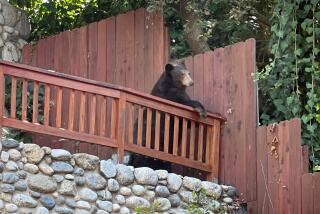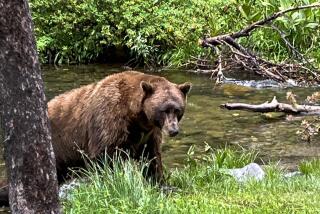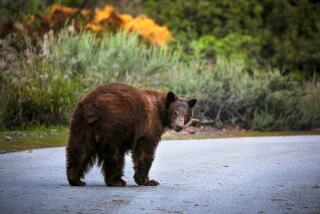Fatal Attraction for People’s Garbage : Naturalists Work to Save Alaska Grizzlies From Civilization’s Advance
- Share via
JUNEAU, Alaska — Alaska game biologist John Schoen likes to show visitors three things: pictures of grizzlies, pictures of garbage and the grim count of bears killed wherever the two are found together.
Schoen says garbage and dead bears are early warning signs that development in Alaska, long thought the last stronghold of the grizzly, is threatening them with the same pressures that drove them to endangerment in the rest of the United States.
Alaska’s population of grizzly bears, estimated at 30,000 to 40,000, isn’t in any danger of being wiped out overnight. But Schoen says unless people find a way to limit increasing conflicts, the bears are in trouble.
More Bear Problems
“With more logging, mining, tourism, recreation going on in southeast Alaska, we’re going to have more brown bear problems,” Schoen says, using the other name the grizzly is known by.
Acting on his and other scientists’ warnings, the state and federal government this year moved to give Alaska grizzlies more protection, primarily by cracking down on open garbage dumps.
Wildlife officials at the U.S. Forest Service, which has counted road building as the main public payoff for logging subsidies in southeastern Alaska’s Tongass National Forest, now say they may try to limit use of those roads, which carry hunters and hikers into areas the bears used to have to themselves.
Schoen began his study after passage of the Alaska National Interest Lands Conservation Act in 1980. The act ensured continued timbering and related road-building in southeastern Alaska. At the same time, tourism officials were predicting boom years for the region.
Schoen got worried because no one could say how the actions would affect the bears. Despite a few isolated studies, little was known about Alaska’s grizzlies, not even their population, he says.
Schoen and his assistant, LaVern Beier, employees of the Alaska Department of Fish and Game, began tracking bears on two islands in the Tongass: Admiralty and Chichagof. Similar studies are being done in other parts of the state.
Indians call Admiralty Kootznahoo --Fortress of the Bears--an apt name for an island with 1,790 square miles and a bear for every one of them.
Admiralty’s bear-per-square-mile density gives it the most concentrated population known in the world of Ursus arctos , the species--formerly called Ursus horribilis --that includes North American grizzlies and European brown bears. The species once ranged from the Mississippi River to the Pacific Coast and from northern Mexico through Canada and Alaska.
Now fewer than 900 grizzlies are left in the continental United States, where they were declared an endangered species in 1975. Canada has an estimated 12,000 to 13,000 grizzlies.
“Now is the time for planning,” says Schoen. “It’s much easier to manage grizzly bear populations when they are healthy than when they’re endangered.”
The scope of the bears-versus-people problem appears in statistics:
- Since 1970, Alaska’s population has jumped from 302,500 to about 540,000. Flush with oil money, state and local governments built thousands of miles of road.
- The number of people visiting the state each year also has exploded, from 129,000 in 1970 to 787,000 in 1986.
- Of the 105 bear maulings documented in Alaska since 1900, more than half have occurred in the population boom of the last 25 years, according to a state study.
- Bear kills are also up, Schoen says. Hunters in southeastern Alaska have been taking 75 to 100 grizzlies a year legally. From 1963 to 1987, people reported killing 53 grizzlies in defense of life or property.
Those numbers alone don’t show a threat to the population, Schoen says. He figures that up to 5% of Alaska grizzlies can be killed in any year without causing long-term harm to the population, and the reported kill rate falls short of that.
Legal Kills Outnumbered?
But he believes unreported kills greatly outnumber the legal take.
“This is very big country and we have very few fish and wildlife officers, so it’s very easy to get away with things,” Schoen says.
Bears reproduce slowly and have a high natural death rate. So, a seemingly minor change in the kill rates can cause a population decline, he says.
Schoen and Forest Service officials believe most illegal kills are linked to garbage dumps.
It has become a nightly spring ritual for police to shoo bears out of garbage cans in Juneau, Ketchikan and other towns. This year, 16 black bears were shot in Juneau because they made garbage raiding a habit and lost their fear of humans. Once a bear stops fearing people it will seek them out--looking for their garbage--even after being relocated hundreds of miles away.
The town bear conflicts don’t worry Schoen too much because they involve the more common and less threatened black bear.
The grizzly problem is centered in logging camps and the small bush towns.
Logging camps are usually found along bays where logs can be rafted or loaded on ships. And many bays form at the mouth of salmon streams where grizzly bears feed.
Schoen says a now-closed camp at Corner Bay was a prime example of the conflict. The camp was next to a salmon stream and had an open dump.
“In 1976 they had 14 different bears in the logging camp. I mean walking right between the trailers. That’s a very serious problem,” he says.
At least two of his collared bears were killed because of the dump, he says.
U.S. Forest Service engineer Les Paul says not much can be done about the campsites. With only so much flat land and limited access, it’s probably not possible to situate camps away from the bears, he said.
Tongass Wildlife Director Phil Janik said the Forest Service may limit road use, permanently or seasonally, in order to give bears more undisturbed territory. Janik and Paul hope an education program in Alaska schools will help save bears’ lives when there are conflicts.
In September, the Forest Service and the Alaska departments of Fish and Game and Environmental Conservation signed a new policy on bears and waste disposal. It will begin taking effect this year when many towns and logging camps are due to renew their state permits for solid waste disposal, says Dick Stokes of Environmental Conservation.
Stokes says the towns have been given notice the state’s getting serious about bear problems.
More to Read
Sign up for Essential California
The most important California stories and recommendations in your inbox every morning.
You may occasionally receive promotional content from the Los Angeles Times.










